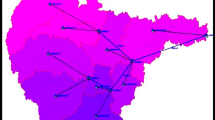Abstract
During the past decade there has been increasing research into the temporal component of geographic information systems (GIS). Most of the research has focused on the treatment of discrete changes in spatial objects, for example in cadastral parcels. However less attention has been paid to the treatment of continuous change which occurs primarily in dynamic objects found in the natural environment, for example in seasonal coastal changes. In order to represent these objects appropriately in a GIS, which by their inherent structure tend to treat the real-world in a discrete manner, temporal interpolation techniques are required. The aim of this paper is to discuss the techniques available for handling the temporal interpolation of spatially dynamic objects, with particular emphasis on changes to their geometric properties. The paper also proposes a range of interpolation methods for three key variants of geometric change.
Similar content being viewed by others
References
J. Clifford and D.S. Warren. “Formal Semantics for Time in Databases,” ACM Transactions on Database Systems, Vol. 8(2):214–254, 1983.
R. Laurini and D. Thompson. Fundamentals of Spatial Information Systems. Academic Press: London,1992.
K. Brassel, F. Bucher, E.-M. Stephan, and A. Vckovski. “Completeness,” in S. C. Guptill and J. L. Morrison (Eds.), Elements of Spatial Data Quality. Elsevier, New York 81–108, 1995.
G. Ariav. “A Temporally Oriented Data Model,” ACM Transactions on Database Systems, Vol. 11(4):499–527, 1986.
G. Langran. Time in Geographic Information Systems. Taylor & Francis: London, 1992.
D. J. Peuquet and N. Duan. “An event-based spatio-temporal data model (ESTDM) for temporal analysis of geographical data,” International Journal of Geographical Information Systems, Vol. 9(1):7–24, 1995.
Y. Shahar. “Knowledge-Based temporal interpolation”. Proceedings of 4th International Workshop on Temporal Representation and Reasoning, Los Alamitos, California, 102–111, 1997.
M. Fahle and G. Bachmann. “Better performance through amblyopic than through normal eyes,” Vision Research, Vol. 136(13):1939–44, 1996.
A. Beller, T. Giblin, K.V. Le, and S. Litz. “A temporal GIS prototype for global change research.” Proceedings of the GIS/LIS 91 Conference, Atlanta, Georgia, 752–765, 1991.
H. Mitasova, L. Mitas, W.M. Brown, D.P. Gerdes, I. Kosinovsky, and T., Baker. “Modelling spatially and Temporally Distributed Phenomena: New Methods and Tools for GRASS GIS,” International Journal of Geographical Information Systems, Vol. 9(4):433–446, 1995.
J.P. Cole and C.A.M. King. Quantitative Geography. John Wiley: 1968.
A. Galton. “Space, time and movement,” in O. Stock (Ed.), Spatial and Temporal Reasoning, Kluwer Academic, Dordrecht, 321–352, 1997.
A.G. Cohn, N.M. Gotts, Z. Cui, D.A. Randell, B. Bennett, and J.M. Gooday. “Exploiting temporal continuity in qualitative spatial calculi,” in M.J. Egenhofer and R.G. Golledge (Eds.), Spatial and Temporal Reasoning in Geographical Information Systems. Oxford University Press: 5–24, 1998.
M.J. Egenhofer and K.K. Al-Taha. “Reasoning about Gradual Changes of Topological Relationship,” in Theories and Methods of Spatio-Temporal Reasoning in Geographic Space, Lecture Notes in Computer Science 639, 196–219, 1992.
E.H. Isaaks and R.M. Srivastava. An Introduction to Applied Geostatistics. Oxford University Press: 1989.
M. Yuan. “Representing Spatio-temporal Processes to Support Knowledge Discovery in GIS Database,” Proceedings of the 8th International Symposium on Spatial Data Handling, Vancouver, Canada, 431–440, 1998.
D.F. Watson. Contouring: A Guide to the Analysis and Display of Spatial Data. Pergamon: 1992.
M. Erwig, R.H. Guting, M. Schneider, and M. Vazirgiannis. “Spatio-temporal data types: An approach to modeling and querying moving objects in database,” GeoInformatica, Vol.3(3):269–296, 1999.
C. Claramunt, and M. Theriault. “Managing time in GIS: An event-oriented approach,” in J. Clifford and A. Tuzhilin (Eds.), Recent Advances in Temporal Databases: Proceedings of International Workshop on Temporal Databases, Springer: 1995.
A.U. Frank. “Different types of “times” in GIS,” in M.J. Egenhofer and R.G. Golledge (Eds.), Spatial and Temporal Reasoning in Geographic Information Systems. Oxford University Press: 40–62, 1998.
C. Claramunt. “Managing time in GIS: An event-oriented approach.” Recent Advances in Temporal Databases: Proceedings of International Workshop on Temporal Databases, Zurich, Switzerland, 21–42, 1995.
N.W.J. Hazelton. “Integrating time, dynamic modelling and GIS: Development of 4-D GIS”. Unpublished Ph.D Dissertation, The University of Melbourne, Melbourne, Australia, 1991.
T. Cheng and M. Molenaar. “A process-oriented spatio-temporal data model to support physical environmental modeling.” Proceedings of the 8th International Symposium on Spatial Data Handling, Vancouver, Canada, 418–430, 1998.
Author information
Authors and Affiliations
Rights and permissions
About this article
Cite this article
Zhang, W., Hunter, G.J. Temporal Interpolation of Spatially Dynamic Object. GeoInformatica 4, 403–418 (2000). https://doi.org/10.1023/A:1026518013333
Issue Date:
DOI: https://doi.org/10.1023/A:1026518013333




